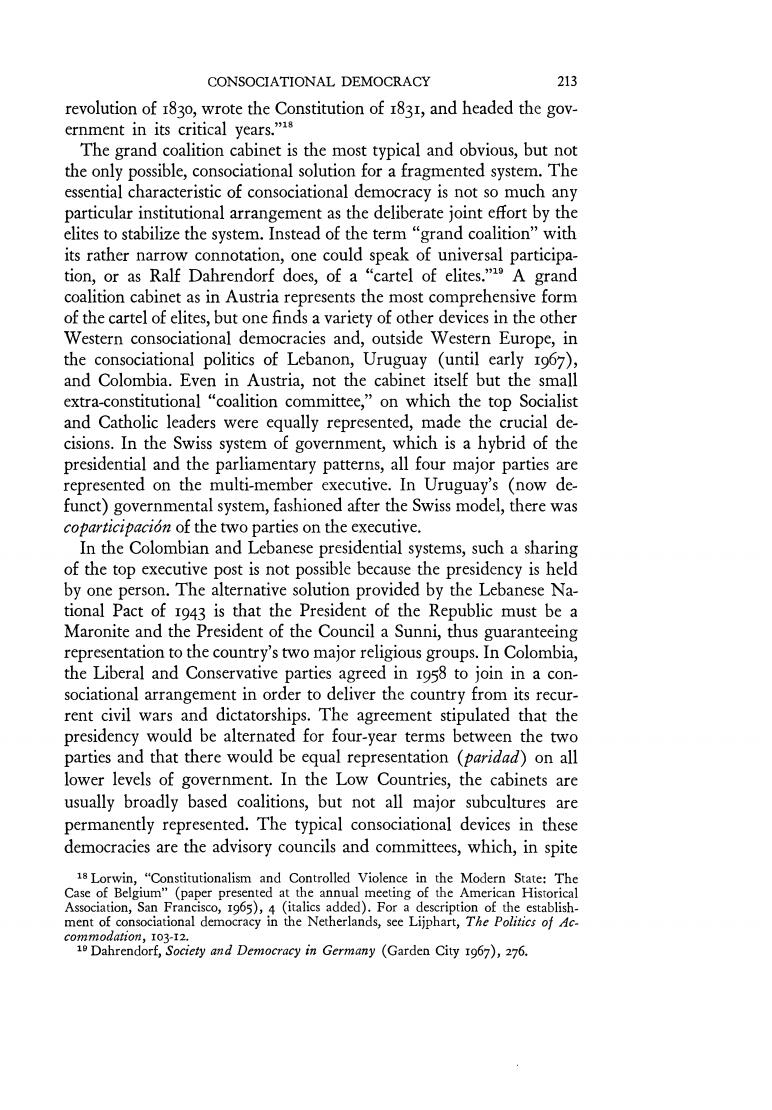正在加载图片...

CONSOCIATIONAL DEMOCRACY 213 revolution of 1830,wrote the Constitution of 1831,and headed the gov- ernment in its critical years." The grand coalition cabinet is the most typical and obvious,but not the only possible,consociational solution for a fragmented system.The essential characteristic of consociational democracy is not so much any particular institutional arrangement as the deliberate joint effort by the elites to stabilize the system.Instead of the term"grand coalition"with its rather narrow connotation,one could speak of universal participa- tion,or as Ralf Dahrendorf does,of a "cartel of elites."4A grand coalition cabinet as in Austria represents the most comprehensive form of the cartel of elites,but one finds a variety of other devices in the other Western consociational democracies and,outside Western Europe,in the consociational politics of Lebanon,Uruguay (until early 1967), and Colombia.Even in Austria,not the cabinet itself but the small extra-constitutional "coalition committee,"on which the top Socialist and Catholic leaders were equally represented,made the crucial de- cisions.In the Swiss system of government,which is a hybrid of the presidential and the parliamentary patterns,all four major parties are represented on the multi-member executive.In Uruguay's (now de- funct)governmental system,fashioned after the Swiss model,there was coparticipacion of the two parties on the executive. In the Colombian and Lebanese presidential systems,such a sharing of the top executive post is not possible because the presidency is held by one person.The alternative solution provided by the Lebanese Na- tional Pact of 1943 is that the President of the Republic must be a Maronite and the President of the Council a Sunni,thus guaranteeing representation to the country's two major religious groups.In Colombia, the Liberal and Conservative parties agreed in 1958 to join in a con- sociational arrangement in order to deliver the country from its recur- rent civil wars and dictatorships.The agreement stipulated that the presidency would be alternated for four-year terms between the two parties and that there would be equal representation (paridad)on all lower levels of government.In the Low Countries,the cabinets are usually broadly based coalitions,but not all major subcultures are permanently represented.The typical consociational devices in these democracies are the advisory councils and committees,which,in spite 18 Lorwin,"Constitutionalism and Controlled Violence in the Modern State:The Case of Belgium"(paper presented at the annual meeting of the American Historical Association,San Francisco,1g65),4 (italics added).For a description of the establish- ment of consociational democracy in the Netherlands,see Lijphart,The Politics of Ac. commodation,103-12. 19 Dahrendorf,Society and Democracy in Germany (Garden City 1967),276